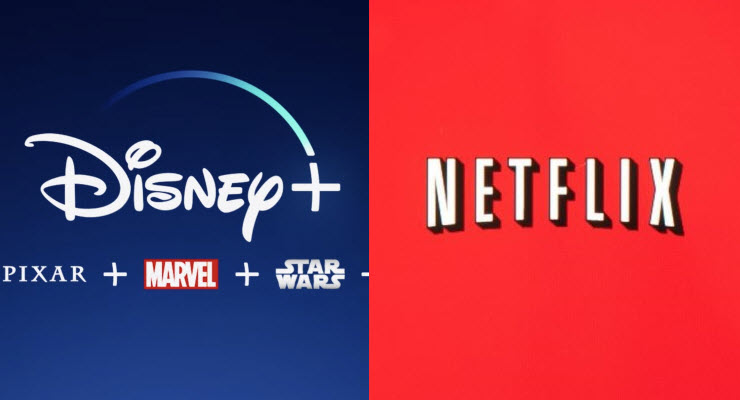
Once a Mickey Mouse operation, Disney has bulked up. In 2019, the US content company spent US$71 billion buying 21st Century Fox. It has previously acquired Pixar, Marvel and Lucasfilm, which is behind Star Wars. Now that bulk is being put to use with the launch of its new streaming service, Disney+.
In preparing to launch, Disney has foregone many hundreds of millions in ridiculously easy money by withholding content it could license to other streaming companies. Early signs in the US indicate it may have paid off, with 10 million subscribers on the first day. That was ahead of expectations, popping Disney stock up 7%.
Disney+ launched in Australia on Tuesday. The streaming industry in Australia is getting incredibly crowded. On top of those already mentioned, Aussies can subscribe to Amazon Prime, Kayo, Ten All Access, Foxtel Now, and the free ones — ABC iView, SBS On Demand, etc.
In the US the battle for supremacy is even more of a melee, with Apple TV, Hulu, and HBOMax all serious contenders for the consumer dollar. The market is heating up because the profits are potentially huge if a company can just get big enough.
Scaling up
The business model of a streaming company like Netflix is different to most companies. It pays once to make or buy a popular show. It then sells that show to as many customers as it can. After a while it breaks even, after which every extra customer is pure profit. The bigger it gets, the smaller the cost of the show seems compared to the revenue coming in.
Every time a streaming service’s customer base expands, its average cost per customer falls. This is what economists call “a downward sloping average cost curve”.
These kind of cost curves are usually associated with natural monopolies. We often put natural monopolies in the hands of government because otherwise there’s a risk that prices may be set too high. But Netflix and Disney+ are pretty cheap, right?
The Amazon Effect
In today’s American business environment, investors scoff at profit. Everyone wants to bet on companies that are doing what Amazon did: getting massive. Profit takes a distant backseat to scaling up. The idea is to springboard into a monopoly position and then, at some point in the far distant future, raise prices so profit gushes out, nearly drowning investors.
Having seen what Amazon did, businesses are trying to replicate it in every space. In the streaming industry, aiming to be the winner who takes all is especially vital, because of the advantage of scale.
This is going to mean competition — for a very long time. The TV streaming space might have a downward sloping cost curve but it will not see a monopoly, not for the foreseeable future. A fierce battle will be fought.
Remember newspapers?
The industry that best demonstrates what the battle for TV streaming supremacy will look like is the one you’re engaging with right now: news media.
We all know the frustrations of news subscriptions. If you’re reading this, you’re a subscriber. Many people subscribe to two or three news outlets, some to four or five, a few to six or seven. But there are usually more outlets a person might wish to read than subscriptions they can buy.
All too often I find myself bumping into a paywall at Bloomberg or The Washington Post. Similarly, paywalls are going to keep us from some shows we’d really rather watch.
While the prices of the multiple streaming services may stay low during the competition phase, the consumer choice will still be frustrating. This will be mirrored inside the TV streaming companies. None will be operating at quite the scale they want, and all will face an ugly trade-off between cutting prices to increase subscriber numbers, or raising prices to reduce their losses.
If the media is anything to go by, a “metered model” might well emerge to help bridge frustrations — allowing a few free stories each month. Perhaps Netflix will tempt us with an hour of free viewing a month, hoping that acts more to whet our appetite than sate it.
But the lessons of news media are cautionary, too. Mergers and bankruptcies have torn through the sector, transforming it into something unrecognisable. Expect the same in the TV streaming industry.








Expect to see something like a paywall aggregator like Inkl does for news sites, but for streaming. I’m sick of multiple streaming subs. Really sick of it.
“Once a Mickey Mouse operation,”
Very droll.
You’d have to think that regardless of market size it has to come down to 2 or 3 players, max.
People might subscribe to 2, maybe 3, but except for tragics that will be the limit.
I’ve always thought the eventual victor would be a ‘free’ subscription option with ads. So just like traditional TV. This would give people broader access, maybe tempt them to get a subscription, whilst maybe lowering piracy as you can access that one show you want.
Streamers like Foxtel are greedy, they want to sell subs and have ads
When NY Times offered a $1/week subscription I took it. I imagine many people worldwide did also. Foxtel will suffer when movies and sports come direct from the studios or sporting bodies. The day will come when I won’t have to pay Foxtel’s extortionate fees just to watch a game of soccer or tennis.